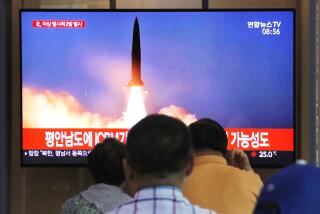Chernobyl’s Fallout Exceeded Hiroshima : Disaster’s Output Termed 30 Times Heavier Than WWII Bombs
- Share via
TOKYO — The Soviet nuclear accident at Chernobyl was believed to have released 30 to 40 times as much lethal ash as the atomic bombs dropped over the Japanese cities of Hiroshima and Nagasaki in 1945, according to Japanese news media reports.
The Soviet Union, in a report delivered last week to the International Atomic Energy Agency (IAEA), blamed human error for the April 26 disaster that has killed 31 and injured hundreds, the Asahi newspaper and Kyodo News Agency reported.
The Russian-language report, presented to the Vienna-based agency on Thursday, disclosed that about 50 megacuries of fission products, excluding rare gases, were released into the atmosphere, the Asahi said.
This was the equivalent of 3.5% of the radioactive materials present at the reactor core and “several ten” times the lethal ash produced by the Hiroshima atomic bomb, it said.
Difficult Comparison
Dr. Shunzo Okajima, a radiation physics expert, told reporters, “It is difficult to compare Chernobyl with Hiroshima or Nagasaki because fission products involved are different.”
But he added, “Roughly speaking, the Chernobyl accident is estimated to have released an equivalent 30 to 40 times those the Hiroshima or Nagasaki A-bombs released.”
Okajima, of Nagasaski University, is an adviser to the Radiation Effects Research Foundation, a U.S.-Japanese Organization examining radiation effects on survivors of the nuclear blasts in the two cities.
The atomic bomb dropped over Hiroshima at the end of World War II killed an estimated 140,000 people and the one over Nagasaki about 70,000. Names of people killed by the effects of the two bombs are still being added to the official list of victims.
The Asahi quoted the Soviet report as saying that the Chernobyl accident, involving the No. 4 reactor, occurred during experiments with a turbine generator.
Researchers were trying to see how much electricity could be produced through turbine inertia by halting a flow of steam to the generator from the reactor.
It said the Soviet report denied that there was a meltdown of the reactor fuel rods. It said the emergency system designed to shut down the reactor automatically and flood it with water was shut off as part of the experiment.
Safety Violations
The report said safety regulations had not been followed in a number of areas and cited the most serious violations as:
--The nuclear reactor’s protective devices failed to function because control rods were put into operation beyond permissible levels.
--Because the automatic control system, which regulates the reactor’s power level, was inactivated, the reactor output dropped more than planned and the reactor core became unstable.
--Under the experiment, eight recycling pumps were turned on, heating the coolant to a point where it was no longer effective.
--Operators disengaged a program to shut off the reactor and the turbine, making it impossible for the reactor to shut off automatically.
--The reactor’s cooling device was switched off to ensure that it would not be activated during the experiment.
The Japanese reports said the International Atomic Energy Agency was expected to hold a meeting Aug. 25 to discuss to Soviet report.
More to Read
Sign up for Essential California
The most important California stories and recommendations in your inbox every morning.
You may occasionally receive promotional content from the Los Angeles Times.










